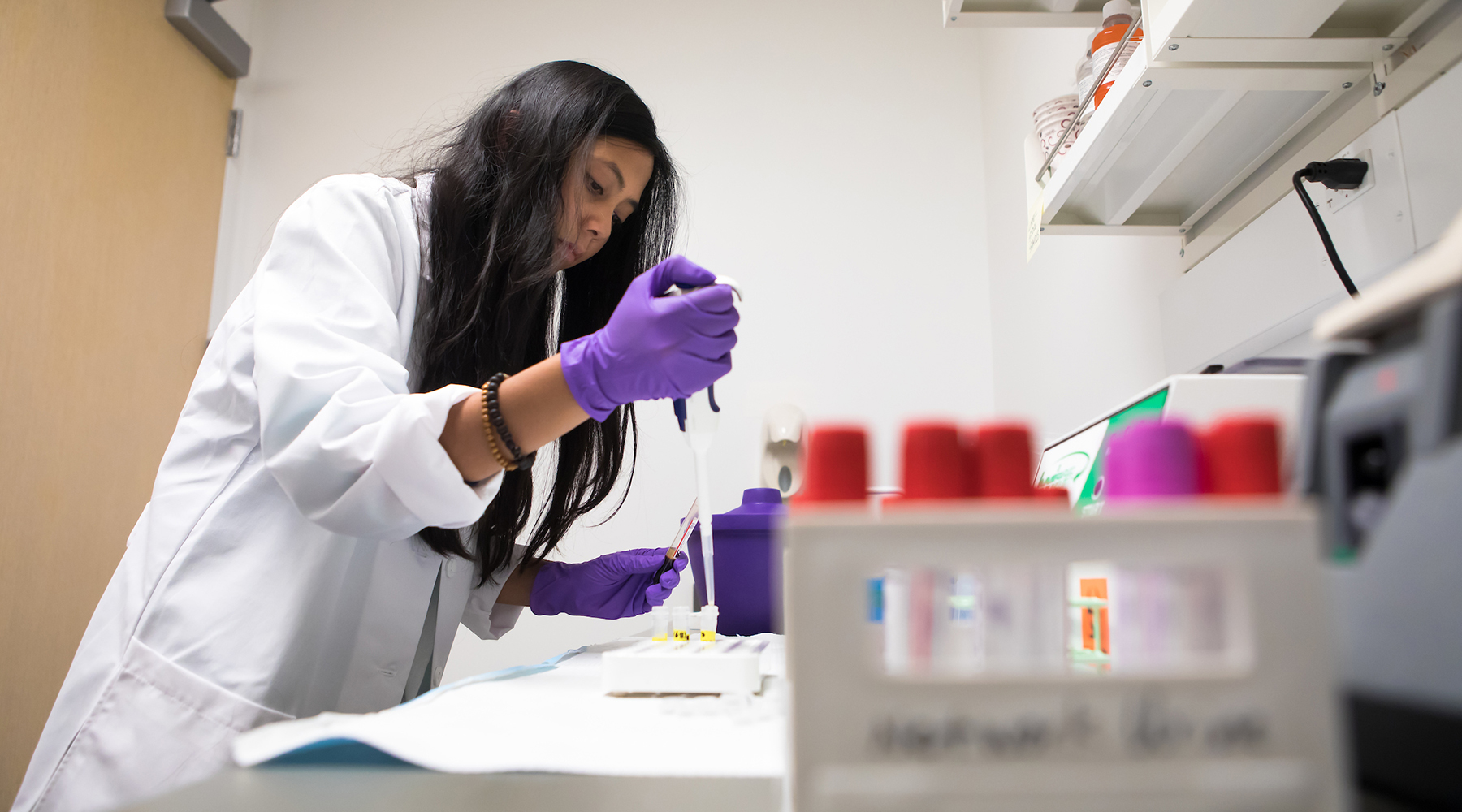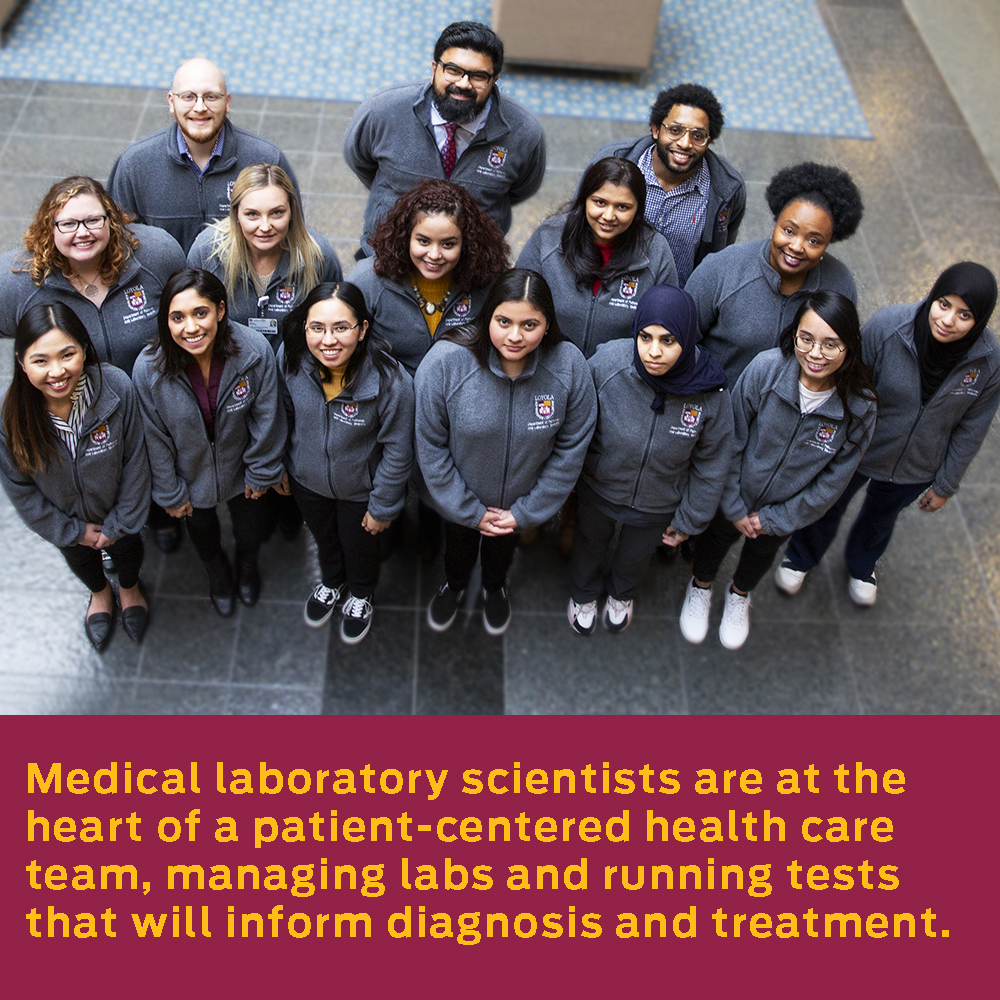Hidden Heroes

Kristen Pesavento is an instructor at Loyola’s Parkinson School of Health Sciences and Public Health.
Hidden Heroes
Global pandemic highlights importance of medical laboratory scientists
If you are tested for COVID-19, the “testing site” you visit is just the first step in the diagnosis process. It’s at hospital and clinic laboratories where the real work begins.
“The professionals in the laboratories can save lives,” says Amanda Harrington, PhD, associate professor of pathology at Stritch and medical director of microbiology at Loyola Medicine. “We could not do this without the medical laboratory scientists (MLS) and technologists on the ground. They are the hidden heroes.”
One of those hidden heroes is Kristen Pesavento, an instructor at Loyola’s Parkinson School of Health Sciences and Public Health. Pesavento is also a pro re nata (PRN) medical laboratory scientist at NorthShore University HealthSystem’s Evanston Hospital lab, the first lab in the Chicago area to develop a viable COVID-19 test.
“Not many people realize there is a whole workforce of highly trained, certified professionals that are essential to producing any type of health care or medical results,” says Pesavento.
At a time when testing is a vital process, the work of these lab professionals is more important than ever.

Medical lab scientists are in high demand as of late as the number of retired medical lab scientists is far greater than the medical lab scientists being trained.
A medical laboratory scientist uses state-of-the-art biomedical instruments and molecular techniques to develop, implement, and analyze highly complex tests that can detect infections, diseases, or in this case, the SARS CoV-2 virus, known more commonly as COVID-19 disease.
As COVID-19 testing ramps up, medical laboratory scientists face a growing workload on top of their day-to-day duties. Each COVID-19 test takes anywhere from 30 minutes to six hours to complete depending on the testing system, according to Pesavento, and that’s if there are no mistakes. “These are highly complicated tests that require extensive training. Once you receive a sample, you process, extract, amplify, and finally you interpret the results as positive or negative before reporting to a physician,” explains Pesavento.
However, it’s not the complexities of testing that worry Pesavento, but the lack of trained professionals to conduct them. “There’s a nationwide shortage of medical laboratory scientists,” says Pesavento. In fact, many laboratories were short-staffed before the pandemic hit. “Because we are not visible, it was easy to overlook this chronic shortage.”
Two reasons behind the shortage are the high rate at which medical laboratory scientists are retiring combined with the lack of academic programs to help replace those retirees. According to the American Society for Clinical Laboratory Science, 39 MLS programs either closed or lost accreditation between 2000 and 2016.
“Although we don’t see the patients face, each sample that comes in is an actual person. We know there is someone behind these results, every single test, every patient, every day.”
At a time where the profession is not only in demand, but also a critical component in combating the pandemic, medical laboratory scientists like Pesavento are doing everything possible to keep up with demand. That means working overtime and extra days, as well as risking their own safety to make sure patients get their diagnoses in a timely manner. “Although we don’t see a patient’s face, each sample that comes in is a person” says Pesavento. “We know there is someone behind these results, every single test, every patient, every day.”
As the only practicing medical laboratory scientist on Loyola’s faculty, Pesavento hopes to encourage more science-minded students to consider pursuing an MLS degree and become the hidden heroes the country needs in times like these.

A career in medical laboratory science combines the challenges of medicine, pathology, basic sciences, and clinical laboratory sciences. Learn more about the Master of Medical Lab Science program at the Parkinson School for Health Sciences and Public Health. LEARN MORE
Global pandemic highlights importance of medical laboratory scientists
If you are tested for COVID-19, the “testing site” you visit is just the first step in the diagnosis process. It’s at hospital and clinic laboratories where the real work begins.
“The professionals in the laboratories can save lives,” says Amanda Harrington, PhD, associate professor of pathology at Stritch and medical director of microbiology at Loyola Medicine. “We could not do this without the medical laboratory scientists (MLS) and technologists on the ground. They are the hidden heroes.”
One of those hidden heroes is Kristen Pesavento, an instructor at Loyola’s Parkinson School of Health Sciences and Public Health. Pesavento is also a pro re nata (PRN) medical laboratory scientist at NorthShore University HealthSystem’s Evanston Hospital lab, the first lab in the Chicago area to develop a viable COVID-19 test.
“Not many people realize there is a whole workforce of highly trained, certified professionals that are essential to producing any type of health care or medical results,” says Pesavento.
At a time when testing is a vital process, the work of these lab professionals is more important than ever.
A medical laboratory scientist uses state-of-the-art biomedical instruments and molecular techniques to develop, implement, and analyze highly complex tests that can detect infections, diseases, or in this case, the SARS CoV-2 virus, known more commonly as COVID-19 disease.
As COVID-19 testing ramps up, medical laboratory scientists face a growing workload on top of their day-to-day duties. Each COVID-19 test takes anywhere from 30 minutes to six hours to complete depending on the testing system, according to Pesavento, and that’s if there are no mistakes. “These are highly complicated tests that require extensive training. Once you receive a sample, you process, extract, amplify, and finally you interpret the results as positive or negative before reporting to a physician,” explains Pesavento.
However, it’s not the complexities of testing that worry Pesavento, but the lack of trained professionals to conduct them. “There’s a nationwide shortage of medical laboratory scientists,” says Pesavento. In fact, many laboratories were short-staffed before the pandemic hit. “Because we are not visible, it was easy to overlook this chronic shortage.”
Two reasons behind the shortage are the high rate at which medical laboratory scientists are retiring combined with the lack of academic programs to help replace those retirees. According to the American Society for Clinical Laboratory Science, 39 MLS programs either closed or lost accreditation between 2000 and 2016.
At a time where the profession is not only in demand, but also a critical component in combating the pandemic, medical laboratory scientists like Pesavento are doing everything possible to keep up with demand. That means working overtime and extra days, as well as risking their own safety to make sure patients get their diagnoses in a timely manner. “Although we don’t see a patient’s face, each sample that comes in is a person” says Pesavento. “We know there is someone behind these results, every single test, every patient, every day.”
As the only practicing medical laboratory scientist on Loyola’s faculty, Pesavento hopes to encourage more science-minded students to consider pursuing an MLS degree and become the hidden heroes the country needs in times like these.
